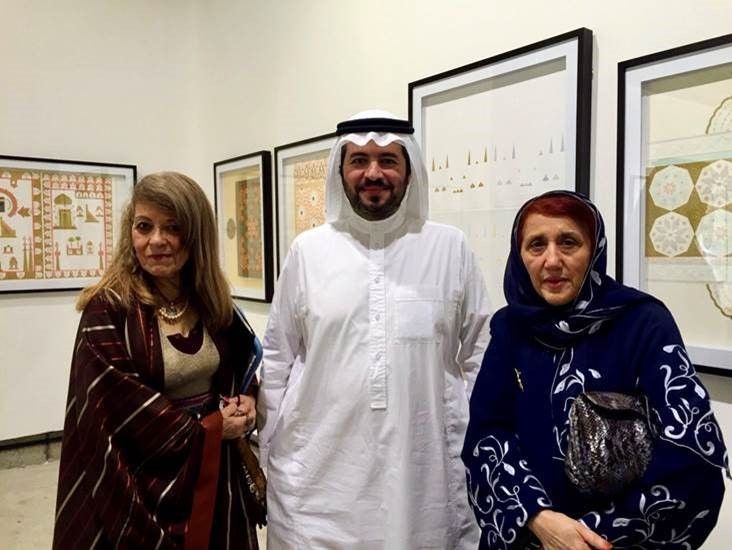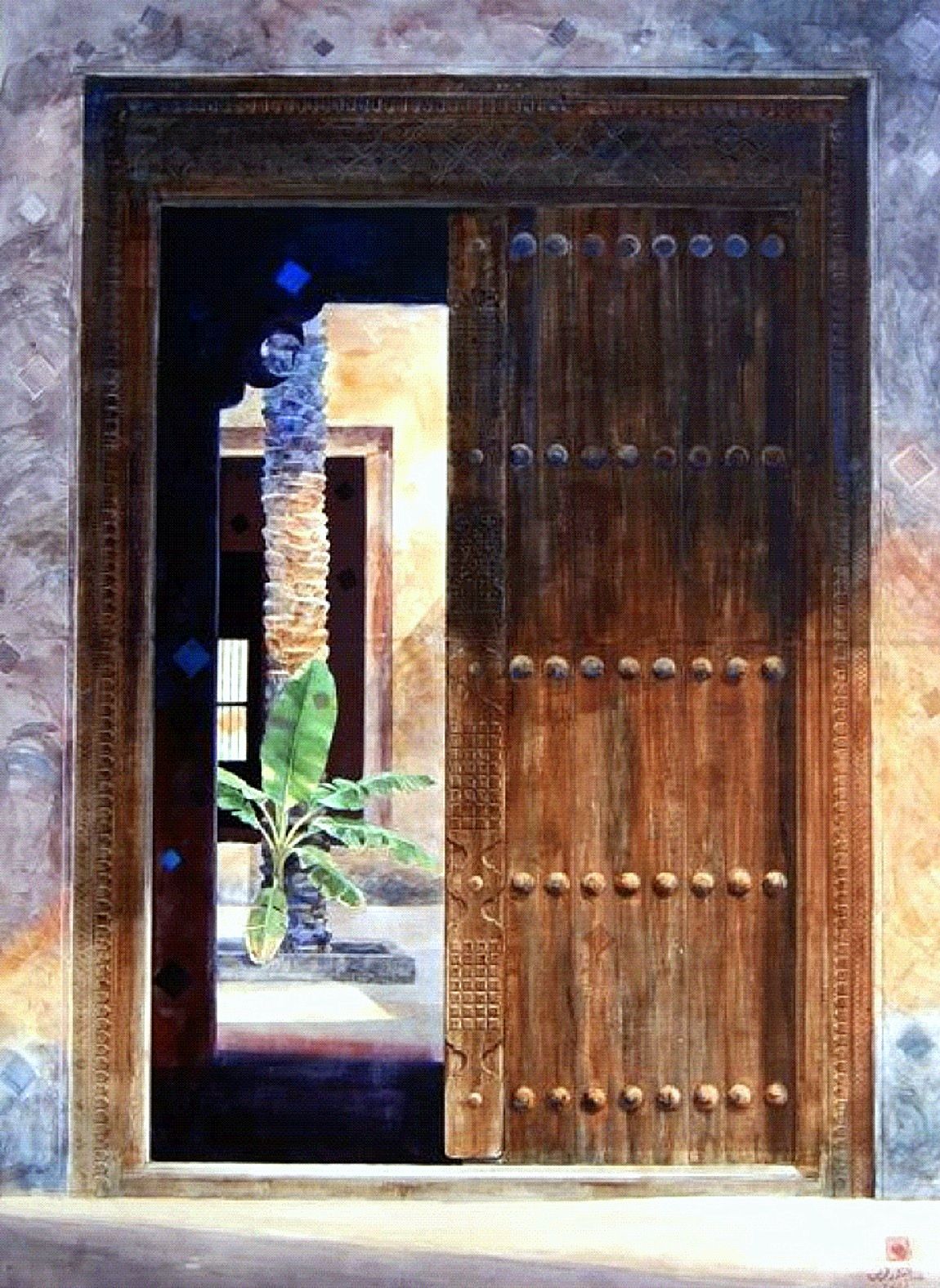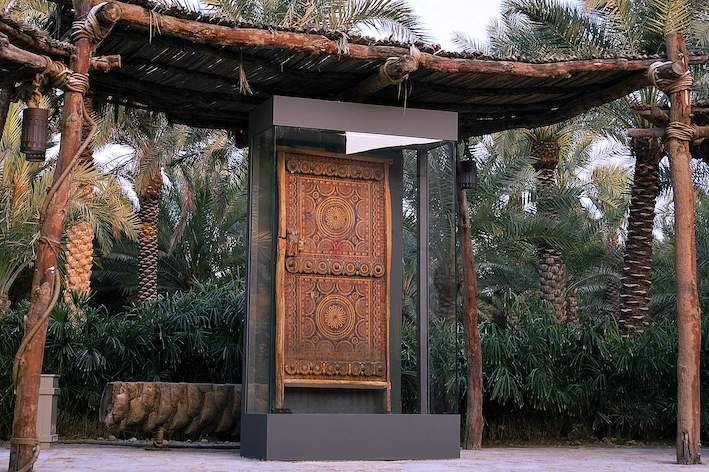Mounirah Mosly - Portrait of a Patriot
The Young Woman (2010), by the late Saudi artist Mounirah Mosly. Painting-mixed media on paper. Acquired 2011. Part of Ithra Museum Collection. Photo by Ahmed Althani.
Saudia Airlines has honored the late artist Mounirah Mosly – may she rest in peace – in its booklet Pioneers of the Fine Arts Movement in the Kingdom of Saudi Arabia, presented by the artist and art critic Abdulrahman Al-Soliman. In addition to Mosly, the list of four pioneering artists includes Abdulhalim Radwi, Mohammed Al-Saleem, and Safiya Bin Zager. Such esteem and reverence for Mosly demonstrates the impact of what was truly an impassioned, prismatic - and sometimes daring - artistic journey which spanned five decades from the 1960s until her untimely death in 2019. It would be a tragedy to chronicle the history of art in Saudi Arabia without first pausing to reflect on the experiences and vast contributions of the late Mounirah Mosly, considered to be one of the first-generation pioneers in the Kingdom's fine arts, opening new doors for those who would come later.
Mounirah Mosly was born in Makkah to a distinguished family that valued education, philosophy and creative expression. In these surroundings, Mounirah began drawing at the age of 12. Her father chose Lebanon for her high school education, followed by academic studies at the Faculty of Fine Arts at Cairo University in the mid-1960s. At that time, both Beirut and Cairo were vibrant with cultural life. In 1978, Mounirah earned a postgraduate diploma in graphic design in the United States and joined Aramco as a public relations specialist and an expert in printing and media design later that year. She displayed her work in specialized exhibitions such as the “drupa” printing equipment exhibition in Germany and as an Artistic Specialist in the Arab Gulf Program in support of the United Nations Development Organizations.
Mounirah forged a new trail in the field of art, driven by a mesmerizing talent and an almost stoic persistence, with an abiding belief in the consequence of art to life itself, to the making of civilization. She held her first joint exhibition with artist Safeya Binzagr at the Modern Education School in Jeddah in 1968 and her first solo exhibition in Jeddah in 1972. Her exhibitions and participation continued in cities across the Kingdom, the Gulf, the Arab World, and in 12 U.S. states and several European countries. She won numerous art awards, and many of her works are held in Arab and international museums.

‘The Land of Solidities’, by Saudi pioneering artist Mounirah Mosly. Dated 1970, oil on wood, 110 x 80 cm. Image courtesy of Barjeel Art Foundation, Sharjah.
Mounirah expressed her experiences in art, work, and life with intense poetic brevity by saying: “I belong to all civilizations, all races, all arts and all times. I reflect upon them daily whenever I feel lonely and lack vision. I live in constant alienation, and I am in a continuous, restless search. Painting is my world; it allows me to see life with freedom as its canvas. I'm captivated by what lies beyond the wealth and beneath the surface; its details are endless mysteries. I was born with this passion, and I will die with it, too."
Mounirah was open to the world, with an enlightened and cultured nature of virtues deeply rooted in her Arab identity and human values. She was known as a pioneer of non-traditional art. She was strong and sincere, and spoke her heart in a way that was translucent and vulnerable. She was also serious and logical, to the point that some might have viewed her as overwhelming. She treated each person based on her sense of the unique value they added, regardless of their position. Those who knew Mounirah closely understood the gentle purity of her intentions and perhaps saw that a young child still resided within her, whispering to her creative curiosity and need for continuous innovation.

Mounirah Mosly with Fuad Al-Therman in 2011. Courtesy of Aramco Archives.
In her introduction to a dual exhibition titled “Basma” (Arabic for fingerprint) held by Mounirah in 1992 in Jeddah with fellow artist Amina Abdullah, she mentioned that fine art is not limited to painting alone; it is the overall aesthetic impact of humans throughout every aspect of their lives."
Mounirah often explained her need to learn from and to explore whatever she encountered in her daily life. She was affected by music, sculpture and the unfathomable suffering of people across the world, all of which influenced her works. She described herself as a person connected to the earth and its raw materials, with colors playing a leading role in her works.
Literary critic Dr. Mu’jib Al-Zahrani described her process of experimentation with different materials, forms, and techniques, indicating a conscious dialogue with things, beings, colors, and the values of collective heritage, both symbolic and real. Abdulrahman Al-Soliman pointed out that among the pioneers, Mounirah was the most prominent in rebelling against prescriptive paths, with noticeable literary inclusions in her works, such as Liberation, Waves Without a Sea, The Defeated Butterfly, and her works for the children of this generation exhibited at Art Dubai in 2016.
In my opinion, Mounirah transcended the boundaries of traditional norms and explored ways to reinvent them. Many of her artworks are hung unframed, or framed with decorative edging in local heritage motif, resembling remnants of old windows and doors. In February 2016, she presented an exhibition titled “On the Stairs of Color, There Are Traces of My Steps,” showcasing her artistic journey and experience in its various stages over a week’s time, coinciding with the arts festival. During this event, she expressed her wish for the establishment of specialized art colleges and institutes in Saudi Arabia, built upon academic foundations in alignment to the global fine arts movement; and the creation of contemporary art museums in major cities, in addition to institutions and companies that would acquire artists’ works to create healthy demand for art. By the grace of God, Vision 2030 came just two months later, placing arts and culture at the heart of Saudi development.
Ever since I joined Aramco in the early 1990s, I had heard of a great Saudi artist working at the company, who had won several awards and even recognition from the United Nations. Whenever her name was mentioned, I associated it with Al-Wasiti, which was in the title of an exhibition she had held in the late 1990s: Al-Wasiti and I. At that time, I didn't know that Al-Wasiti was one of the most important Arab painters and calligraphers over 700 years ago, known for his miniatures and as a founder of the Baghdad School of Illustration. At the time, I didn't understand the connection between Mounirah and Al-Wasiti. Dr. Maha Al-Senan - an academic in the field of visual arts and heritage and a member of the Saudi Shura Council - says Mounirah invoked Al-Wasiti’s work "not to revive him, but to draw creative inspiration from him and to resume a severed connection in expression. She drew from him the roots of Islamic illustration that accompany manuscripts."
I got to know Mounirah well when I had the honor of working closely with her in Aramco’s Public Relations Department from 2000 until her early retirement in April 2003. She had a contemporary appearance, wearing clothes and accessories that reflected her interest in the arts, and with her hair leaning towards blonde, giving her a blend of East and West. I learned then that Mounirah had a significant role in organizing and judging the children's annual art contest, which Aramco ran between 1978 and 2012.
I was in awe of her depths of human sensibility, which manifested in her ongoing artistic expressions of childhood. This was only matched by her patriotism, Arab identity and devotion to and concern for the Palestinian cause. I remember taking my daughters Deema, who was then six, and Dana, who was three, to visit Mounirah after work one day. She sat with them and was keen for them to draw. At that moment, I thought if my daughters knew that they had the honor of learning for an hour from such a master figure, they would have felt immense joy and gratitude. I still keep a small stone-shaped piece decorated with Arabic calligraphy, which she gifted me after I left the Publishing and Media Relations Division.
After her early retirement from Aramco, we kept in touch for 15 years. We organized a visit for her to the Ithra Center’s temporary offices in Dhahran in 2011, when the site was still under construction. Mounirah enjoyed the visit and was pleased by the endeavour. During that time, the museum team at Ithra acquired The Young Woman, one of her most prominent artworks, which she had hoped to one day see displayed there.
While writing these words and searching through sources of information, I realized the importance of having a well written book dedicated to Mounirah’s legacy and artworks, which probably amounted to nearly 100 pieces. In my opinion, one of her most notable works is "My Land and My People,” which won against 20 international artists competing to design a poster for a United Nations event promoting women's empowerment issues.

The Young Woman, by the late Saudi artist Mounirah Mosly, Painting-mixed media on paper. Acquired 2010. Part of Ithra Museum Collection. Photo by Ahmed Althani.
Mounirah passed away on Friday, January 11, 2019, and we were devastated by the news. The Minister of Culture, His Highness Prince Badr bin Abdullah bin Farhan Al Saud published a condolence message on his Twitter page and directed that one of the major art galleries in the Kingdom be named after her in recognition of her outstanding efforts and contributions to culture and society. Her passing sparked a wave of sadness and appreciation. Many prominent cultural figures expressed their deep sorrow for her loss and their appreciation for her artistic brilliance and human-centric legacy.
Literary critic Dr. Abdullah Al-Ghathami said in describing her that "She lived a patriotic life, with an admirable sense of humanity, painting it on her canvases, writing with her brush the deepest meanings of conscience, and championing justice, and the rights of the land and people in Palestine." Dr. Maha Al-Senan, praised her, calling her "Lady of the Land and Mother of Beginnings and Endings," emphasizing her significant role in paving the way for the visual arts’ cultural renaissance in the Kingdom. Poet Saleh Al-Saleh summarized her stature in an article: "She was a glory in her life and will remain a glory after her death; such a person does not disappear except in body."

Mounirah Mosly in one of her exhibitions, courtesy of the Aramco Archives.
Essam Tawfiq, who worked with her and knew her closely, tweeted touching words, saying: "Mounirah cannot depart; never can she. Your feelings, with their vibrant colors, the melody of your brush in its beautiful tune, and your spirit that defies anything and everything, cannot depart. You reside in the hearts of all who had the honor of standing in the presence of your works. You enriched our lives with your uniqueness and creative art, Mounirah; it is not a farewell." Ithra published a tweet extending condolences to the artistic community in the Kingdom and to Mounirah's family: "The late artist worked at Aramco and was one of the most enthusiastic supporters of Ithra's mission. The center is proud to have one of her most prominent works, The Young Woman, in its collection."

Two Saudi fine art pioneers, Mounirah Mosly (left) and Safeya Binzagr (right) at Hafez Gallery in Jeddah in July 2015. Captured by: Fuad Al-Therman
As for me personally, I remember the words with which I bid her farewell: "Goodbye, Mounirah. She left suddenly, and on the stairs of color are traces of her artistic steps that spanned 50 years between Beirut, Cairo, America, Dhahran, Manama, and Jeddah. I had the honor of working with her for 3 years at Aramco. Determination and pioneering were among her defining traits; she paved an uncharted path and was distinguished by an experimental style that combines symbolism and a high sense of Arab and human expression."
I was moved to see her works present at the Diriyah Biennale two years ago, reaffirming the profound creative impact she left in the realm of Saudi fine art and in the hearts of her admirers in the wake of her passing five years ago, as if to once again say to us: "On The Stairs of Color, There Are Traces of My Steps."


